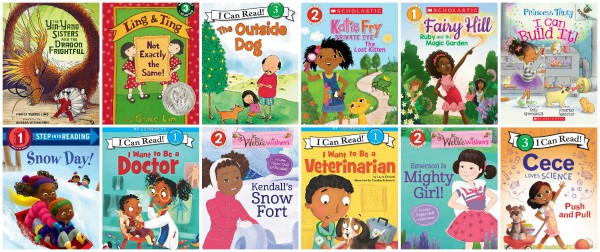14 Mentor Texts to Launch Reading Workshop
This post may contain affiliate links.
A reader recently wrote and asked if I could recommend mentor texts for the first week of Reading Workshop.
So if you’re also a teacher introducing Reading Workshop to your students and looking for mentor texts, here are some book ideas to read aloud to your students.
The picture books below introduce concepts and topics that you will be teaching including book selection, reading identity, reading habits, and thinking about reading.
Mentor Texts to Launch Reading Workshop
How to Select a Book & Choosing a Just Right Book
How do you pick a book that you will like to read? These books introduce book selection and considerations about difficulty.

We’re Going on a Book Hunt by Pat Miller, illustrated by Nadine Bernard Westcott
Hunting for books means you need one that is not too hard or too easy but just right. This is not super meaningful in terms of instructional models but could be a decent introduction for a lesson on book choice and/or just-right books.

Miss Brooks Loves Books! (and I don’t) by Barbra Bottner, illustrated by Michael Emberley
Miss Brooks the library loves books A LOT. Missy says she’ll never love books like Miss Brooks. And she doesn’t. Even the books her mom reads to her. UNTIL…she reads a book about a warty ogre called Shrek–she loves it! Apparently, even ogres like Missy can find something at the library.

The Summer Nick Taught His Cats to Read by Curtis Manley and Katie Berube
Nick does everything with his cats — except read books. That’s why Nick decides to teach his cats to read, too. Verne, the cat, is interested but Stevenson, the cat, is not. Until . . . Nick discovers Stevenson’s drawing. All Stevenson needs are words and he’s written his own story to read.
Thinking About Reading
These books prompt further exploration of reading, why we read, and how books change us– which is good any time of year, not just when you launch reading workshop.

Give Me Back My Book! by Travis Foster and Ethan Long

Thesaurus Has a Secret by Anya Glazer
Thesaurus is a dinosaur who loves words — and something secret, too: reading. When the other dinosaurs find Thesaurus reading, he’s worried about what they will think but they want to hear the rest of the story– and it helps them become readers themselves.

Read! Read! Read! by Amy Ludwig VanDerwater, illustrated by Ryan O’Rourke
The poet celebrates a child’s life filled with reading and the culture of reading! “A book gives you a double life. / It builds a treehouse in your head / a haven you can climb to / when you wish to get away.” The poems show kids reading while eating and at school, readers transported and affected by stories, and readers researching and remembering. “And as I chew I read. / And as I read I chew.“
Reading Habits
What are your reading habits? Do you read in the same chair? Read in the car? Read late at night?
In a reading workshop, take time throughout the year to assess and reflect on reading habits.

How to Read a Story by Kate Messner, illustrated by Mark Siegel
In simple steps, learn how to become a reader — from finding a story and a reading buddy to reading the story out loud to your buddy in a loud, clear voice.

Let Me Finish! by Minh Le, illustrated by Isabel Roxas
Don’t you hate it when people interrupt you when you’re reading? Worse yet, when they ruin the story by telling you what happens!? If so, then you’ll love this hilarious story about just that. Unfortunately, this harassed reading boy just can’t escape the animals who want to tell him everything. And the ending? Well, I won’t tell you. Wouldn’t want to spoil it now would I?

Read the Book, Lemmings! by Ame Dyckman, illustrated by Zachariah OHora
Foxy’s book specifically says that lemmings (small, fuzzy, illiterate rodents) do not jump off cliffs. As soon as he tells the lemmings on his arctic ship, they all jump off the boat. EVEN THOUGH THE BOOK SAYS they don’t jump off cliffs. When telling them what the book says doesn’t work, 3 times in a row, Foxy realizes that it’s because he needs to teach them how to read. Quirky and hilarious.

Just Read by Lori Degman, illustrated by Victoria Tentler-Krylov
Readers celebrate reading on their own accompanied by the characters in her book, choosing anything with words, reading about different places and in different places or with their fingers or their voice. This jaunty rhyming story shows that reading is for anywhere and anytime about anything.
Reading Identity
How do your readers think and feel about themselves as readers?
In reading workshop, it’s important for students to be reflective about who they are as readers.
You might use these picture books to talk about the following questions: Who are you as a reader? Why is that? What kind of books do you like? Do you have a genre preference? What are your goals for your reading life?
These books might help spark new thinking and reflection about a child’s reading identity.

How to Read a Book by Kwame Alexander, illustrated by Melissa Sweet
A luminous, whimsical celebration of the reader’s life with lyrical text, evocative images, and captivating typography. “Squeeze every morsel of each plump line until the last drop of magic/drips from the infinite sky.” Sweet’s layered collages pop with neon color and vibrant images while Alexander’s prose creates rich mental images. This is a dazzling book you’ll want to savor again and again.

A Child of Books by Oliver Jeffers, illustrated by Sam Winston
Travel over mountains of make-believe, lose yourself in forests of fairy tales and live in a home of invention. This is a whimsical trip showing how you belong to the stories you read. Captivating illustrations are made from words and phrases– big, small, curvy, cave-like –from familiar stories adorn each page along with book spines, watercolor art, and ink drawings.

The Book of Gold by Bob Staake

I Do Not Like Books Anymore by Daisy Hirst
Natalie and Alphonse are siblings who love books… until Natalie gets her first reading-by-herself book which is boring. Her frustration is relatable — both with the often boring easy readers (gak!) as well as the patience and practice required for improving. Natalie makes up her own story which her dad scribes. “And Natalie found that, mostly, she could read the book they’d written.” It’s an encouraging, relatable story of growing into your reading identity.

KEEP READING









